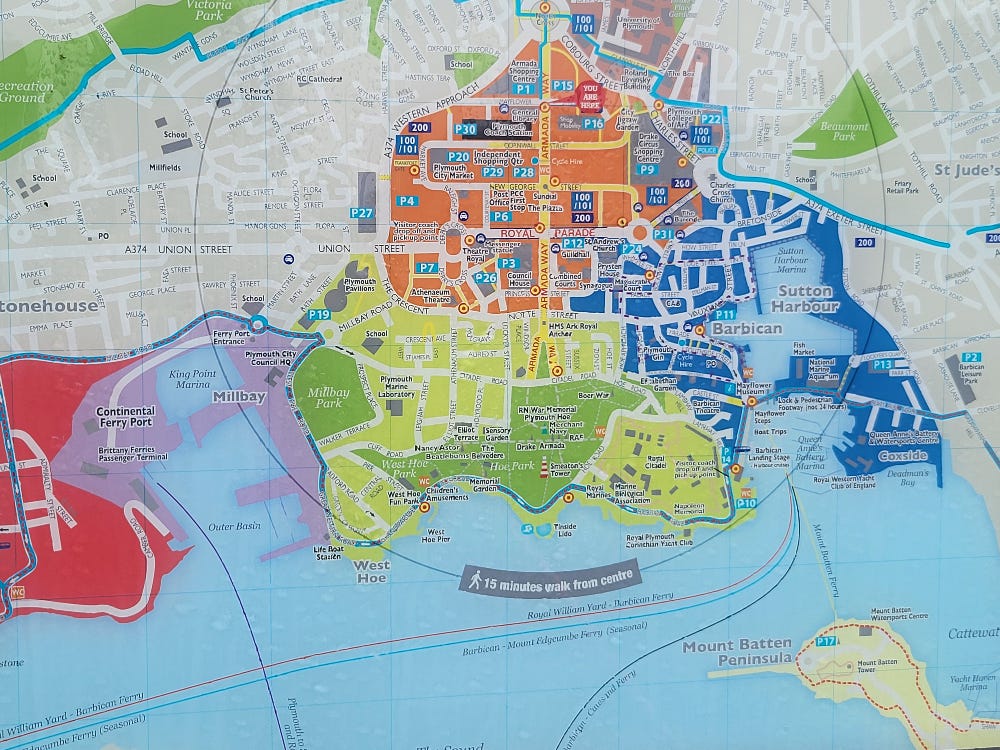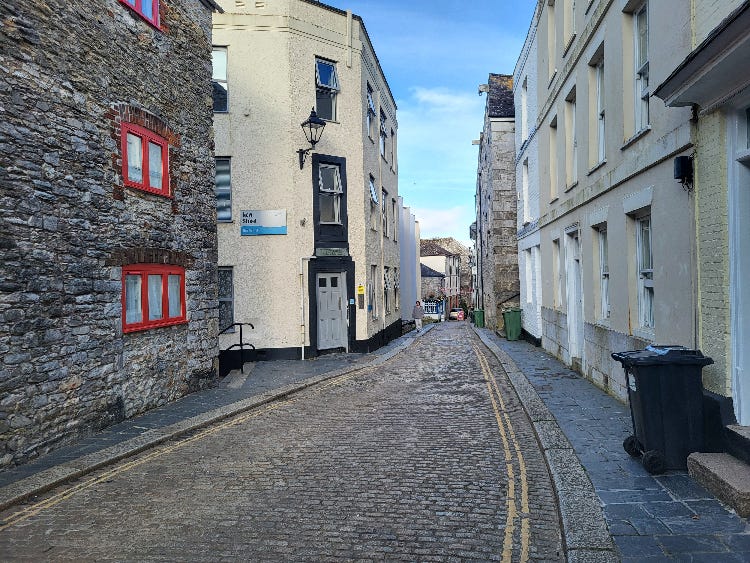Wanderlust
This week: the missing capital of south west England; some German words for the human condition; and a map of London’s greenery.
I am currently off on my travels. I’ve barely left London since the autumn, and have been meaning to get out of town since at least Christmas, but somehow the time just never quite seemed right. One issue has been work; another that, when you’re low, or fear that you might be, there’s a comfort in knowing you can just shut yourself in your room. But partly, too, it’s been a simple question of logistics. Moving around the country on public transport equipped with luggage and accompanied by a dog who is not only no help but, at times, an active hindrance, was simply a lot easier back when there were two of us.
Last weekend, though, a dear friend got married in Devon, which is most of the way in space, if not in time, to another dear friend and occasional co-author who lives in Cornwall, so I decided it was time to bite the bullet. And you know what? It’s been lovely. Totnes turns out to be a delightful old town, with an ancient guildhall and a Norman Castle on a hill. Dartington, the nearby village where the wedding took place, was somehow even prettier. The wedding was beautiful, the weather perfect, the dog has been the best of boys, and has actually proved a useful social lubricant. (Sociable as I am, I’m dreadful at striking up conversations with strangers: a dog who looks like a teddy bear and thinks every stranger is a friend he just hasn’t sniffed yet rather makes that inevitable.)
And so much have I been enjoying this new found freedom that, bitten by a radioactive Bill Bryson at a formative age as I was, I decided to add on a couple more stops.
With somewhere over 300,000 inhabitants, Plymouth is by some distance the largest city on the strangely nameless peninsula which extends into the Atlantic from England’s south west. (Exeter, the runner up at the other end of Devon, can’t quite muster half that.) Thanks to its location on one of Europe’s largest natural harbours, it’s also been hugely important in the country’s maritime history. The Mayflower set sail from there to the New World in September 1620 (although, amusingly, nobody seems quite sure from exactly where); the town gave its name to the resulting colony in Massachusetts. Neighbouring Devonport, which merged with both the main town and East Stonehouse to form the city of Plymouth in 1928, has been an important Royal Navy facility since 1691.1
I visited the city once, at some point in my childhood, and remembered it as being fairly bleak. But I suspected this to have been at least partly because normally on our trips south west we went to Newquay, to stay in what I remember as a magical hotel filled with wonders (but which turned out, when I googled it a few years ago, to be a rather pokey sort of place which just happened to have a games room, two pools and a dessert trolley). Anyway, I’ve been trying for nigh on a decade to visit every sizable city in Britain to get a sense of how it worked, and since I was passing anyway, it seemed like time to visit again.
On this occasion, alas, the memory didn’t cheat. Getting from station to city involved traversing a major road and using some grim subways. The city centre is built around one of those brutalist concrete shopping precincts that post-war Britain specialised in: I’m quite fond of these, because Romford had one too, but you’d be hard pressed to call them pretty, and this one was anyway half empty as much of the local retail business had been sucked into shinier indoor malls. The main shopping street, Armada Way, is coloured green on many maps, but the city council got itself into trouble last year when it tore down its trees in defiance of a public consultation – the scandal brought down the leadership – and although a plan to regenerate it is afoot which requires a bunch of new trees, it’s currently a concrete expanse with occasional hoardings and isn’t green at all.
So with its indoor market hall and its sudden empty spaces, the sense that decline had left the centre with not quite enough people to fill it, Plymouth feels strangely, for want of a better word, northern. This was, considering it’s about as far south as you can get on this island without falling into the sea, unexpected.
As so often happens with post-industrial cities, though, there turned out to be another Plymouth if you bothered to look. At its southern end, Armada Way gives way to some squares with nicer architecture and then the green spaces of Hoe Park, with its monuments and glorious view over Plymouth Sound. On one side of the Hoe are plush new waterfront flats; on the other, the Barbican district, which takes its name from a fortress, and is today an old town of narrow streets beside a harbour lined with restaurants and bars. When I tweeted that I was in Plymouth, mixed in with the inevitable sneering about brutalism or bad school trips, my mentions were filled with recommendations, suggestions I visit a particular museum or the aquarium and claims it had the best food in Britain. One stranger delightedly told me she’d moved there and never looked back.
I have, as I’ve noted before, been broken by my time editing CityMetric, so that I can no longer visit a British city without wondering what we should do with it. Plymouth clearly has a lot going for it – its history, the view from the Hoe, the unexpected loyalty it inspires – but it equally clearly isn’t firing on all cylinders. The Centre for Cities’ factsheet on the place tells a tale of an economy unusually dependent on manufacturing and the public sector: that’s meant low productivity, low wages and high poverty.
I had a momentary fancy that the city could be a sort of British Barcelona: an industrial maritime city, which could attract tourists with waterfront nightlife despite its lack of beaches. Armada Way would be Las Ramblas; the Barbican, Barceloneta; the role of Barca played by Plymouth Argyle. But quite apart from the relative lack of sunshine, the city suffers from the problem that it is almost literally the last place in Devon or Cornwall a tourist would want to visit.
So, if it’s never going to be small and quaint enough to attract visitors, perhaps it should go the other way. The one thing Plymouth has at present is space, and although its population is big for the region it’s still a fairly small city. With more people it could fill those spaces, attract more service businesses and become a sort of regional capital, playing the role for the south west that Newcastle plays in the north east. That might, as a side effect, generate the extra nightlife, culture and streetlife – the “experience economy” – that would make the idea of it being a sort of Devonian Barcelona very slightly less silly.
There are some flaws in this plan (not least that the north east is not exactly booming either, despite the existence of Newcastle). I’m not sure how we’d make it happen, even if the locals wanted it, which they almost certainly don’t. But it’s striking that the nearest big city is Bristol, two counties and 120 miles away: it feels like one’s missing from the economic geography of Britain, a place that can provide all the stuff the quaint tourist hot spots around it cannot. The peninsula remains poor, despite its frankly ludicrous levels of physical beauty. Doubling the size of Plymouth might help to fix that.
Hey, here’s a video of my face
Why it’s the wrong way around and whether this is my fault I’m not entirely clear. But here’s a promo video I made for Stanfords, listing 10 of my favourite facts from A History of the World in 47 Borders: The Stories Behind the Lines on Our Maps.
The press team were kind enough to cut the opening 20 seconds in which I held the book upside down (”I’ve done a Liz Truss haven’t I shit shit shit”).
This week’s “article blatantly written to promote the book” is this beauty for the Financial Times: where does a city begin, and where does it end?
Not bought the book yet? My god! Never mind, here are some options: Amazon, Waterstones, Stanfords, Foyles.
Some useful German words to describe the human condition
Schattenparker: From schatten (shadow) and parker. The type of wuss who parks in the shade because they’re worried about it getting too hot. Curiously specific.
Fernweh: A sort of opposite of heimweh (homesickness; “ferne” means distance). The desire to be a bloody long way from here. A more melancholic version of…
Keep reading with a 7-day free trial
Subscribe to The Newsletter of (Not Quite) Everything to keep reading this post and get 7 days of free access to the full post archives.





